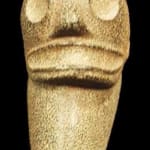Taino Stone Trigonolitos, 1000 CE - 1500 CE
Stone
11 x 6.25
AM.0082
Three-pointers are amongst the most distinctive and fascinating of Taino art forms. Many feature anthropomorphic or zoomorphic designs of great complexity and their exact meaning is still disputed by scholars...
Three-pointers are amongst the most distinctive and fascinating of Taino art forms. Many feature anthropomorphic or zoomorphic designs of great complexity and their exact meaning is still disputed by scholars today. Carved from a dense, hard stone, this example depicts a human face, positioned as if it were lying on its back looking upwards. Although not an exact replica of a skull, the facial features, particularly the sunken eye sockets and wide mouth, are suggestive of a skeletal form. A raised band, incised with geometric motifs, probably represent a headdress of some kind.
The Taino culture flourished in the Caribbean c.1200-1500. The arrival of the Spanish in 1492 resulted in its rapid decline but objects such as this testify to the high quality of craftsmanship. The Taino left no written language so our knowledge about them derives solely from archaeology and the testimonials of the Spanish settlers. As a result, although significant numbers of three-pointers survive, their precise function within Taino society is unclear. The central cone of these triangular objects has been interpreted in a variety of ways. Suggestions include manioc shoots (one of the main crops of the Taino), volcanoes, the roofs of Taino houses, phalluses and the human breast. None of these theories has been universally accepted and the precise origins of the shape are likely to remain a mystery. Despite this many scholars agree that these ceremonial objects were symbols of power and fertility. This seems to be supported by a letter written by Columbus in which he reports on his findings among the Taino, ‘Equally the majority of caciques (chiefs) have three stones to which they and their people have great devotion. One they say is for the fertility of the grain and vegetables that they grow; the next for mothers to give birth without pain, and the third for the water and sun when they have need.’ (AM)
The Taino culture flourished in the Caribbean c.1200-1500. The arrival of the Spanish in 1492 resulted in its rapid decline but objects such as this testify to the high quality of craftsmanship. The Taino left no written language so our knowledge about them derives solely from archaeology and the testimonials of the Spanish settlers. As a result, although significant numbers of three-pointers survive, their precise function within Taino society is unclear. The central cone of these triangular objects has been interpreted in a variety of ways. Suggestions include manioc shoots (one of the main crops of the Taino), volcanoes, the roofs of Taino houses, phalluses and the human breast. None of these theories has been universally accepted and the precise origins of the shape are likely to remain a mystery. Despite this many scholars agree that these ceremonial objects were symbols of power and fertility. This seems to be supported by a letter written by Columbus in which he reports on his findings among the Taino, ‘Equally the majority of caciques (chiefs) have three stones to which they and their people have great devotion. One they say is for the fertility of the grain and vegetables that they grow; the next for mothers to give birth without pain, and the third for the water and sun when they have need.’ (AM)



